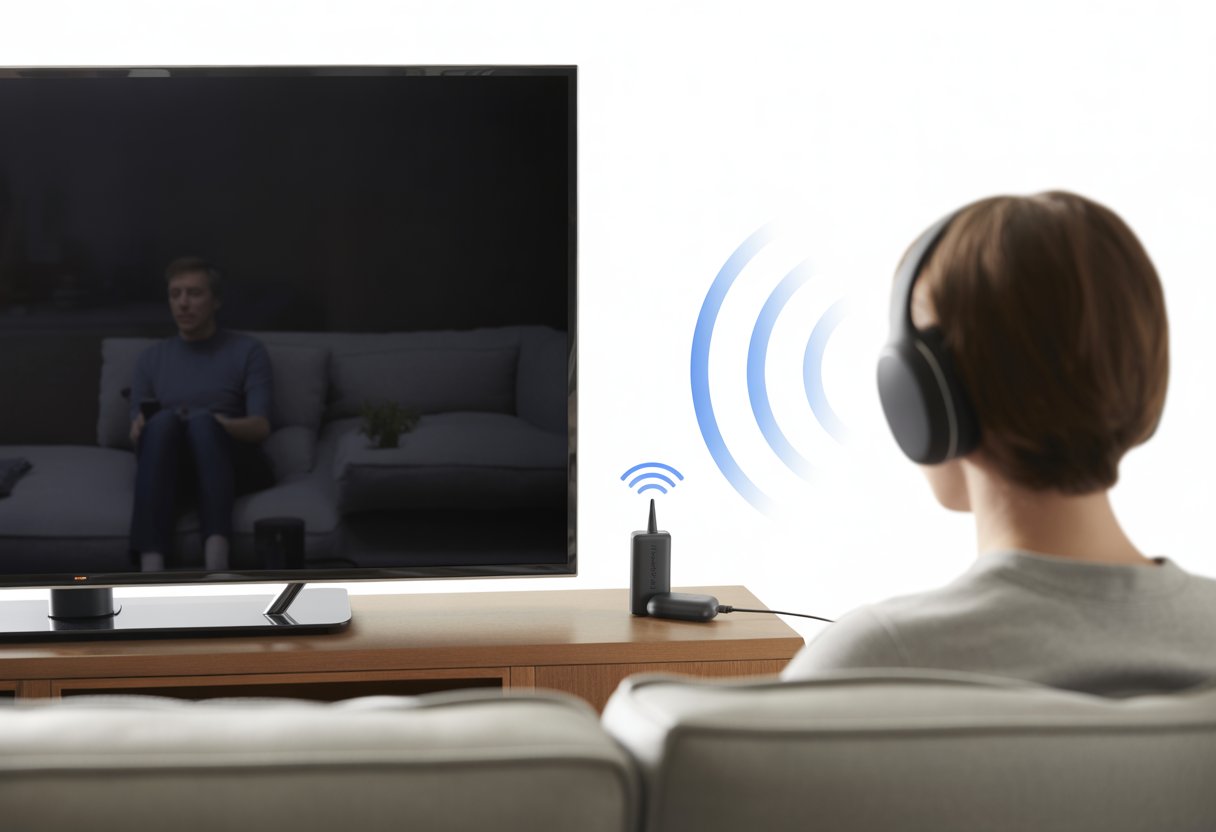Let’s be honest, nobody wants to wake up the neighbors—or the baby—just to catch the end of a movie. Bluetooth headphones can save the day, letting us enjoy our “secret” late-night snacks and movie marathons without anyone knowing. No more tripping over wires or getting blasted by commercials at 2 a.m.

The good news? Connecting Bluetooth headphones to a TV isn’t rocket science.
Most modern TVs let us pair devices easily through their settings.
If our TV doesn’t have Bluetooth, a simple Bluetooth adapter can fix that.
Ready to catch that plot twist in silence? Or maybe dance to our favorite show tunes without an audience? Let’s get started.
Essential Requirements to Connect Bluetooth Headphones to a TV
Before we dive in, we should make sure our setup can handle it.
Having the right TV, headphones, or a handy gadget saves us from hours of frustration and wild button-mashing.
Bluetooth Capability in Modern TVs
Let’s be real, not every TV is as smart as it thinks.
Most newer TVs have Bluetooth, but some older ones just don’t.
Want to check? Head to the TV’s settings and search for Bluetooth or Audio Devices.
Sometimes, it hides under “Sound” or “Connections.”
Quick checklist:
- Peek at the user manual or manufacturer’s site for “Bluetooth” or connectivity info.
- Dig in the TV settings for “Bluetooth” or “Pair new device.”
- Some TVs even tease us with a Bluetooth symbol right on the front.
If our TV is ancient, there’s hope.
A Bluetooth transmitter plugs in and gives us wireless sound—almost like magic.
Checking Your Headphones’ Compatibility
Let’s make sure our Bluetooth headphones aren’t just for show.
Most Bluetooth headphones work with TVs that support Bluetooth audio.
Gaming headphones with their own dongles or older headsets might be a bit stubborn.
Best move? Double-check:
- Can our headphones enter pairing mode? Usually, we hold the power or Bluetooth button until a light flashes.
- Does the manual mention “Multipoint,” “A2DP,” or “TV compatibility?” If not, they might only like phones.
Some TVs only let us connect one pair of headphones at a time.
If you dream of a silent disco movie night, check the manual before buying extra headphones.
Need more details? Here’s a guide on how to connect Bluetooth headphones to TV.
Getting To Know Bluetooth Transmitters
If our TV is older than our favorite slippers, a Bluetooth transmitter can save the day.
This little gadget plugs into the TV’s headphone jack, RCA, or optical port and beams sound wirelessly to our headphones.
Common transmitter connection types:
| TV Output Port | Works With Transmitter? |
|---|---|
| Headphone Jack | Yes |
| RCA (red/white) | Yes |
| Optical (Toslink) | Yes |
| HDMI | No (usually) |
Just plug the transmitter into the right port, put our headphones in pairing mode, and let them find each other.
Most transmitters use simple buttons, so we won’t have to spend hours with the manual.
If our TV is really stubborn, some transmitters work with external audio devices too.
Want more help? Check out this advice on using Bluetooth transmitters for older TVs.
How to Pair Bluetooth Headphones Directly With Your Smart TV
Pairing Bluetooth headphones with our smart TV lets us watch in peace, skip remote battles, and keep Grandma from yelling about the volume.
The process isn’t hard, but we might have to poke around a few menus.
Using TV Settings to Enable Bluetooth Connection
First, we need to introduce our TV and headphones.
Grab the remote and head to the settings menu—usually a gear icon or menu button.
Look for the Sound or Connections section.
There should be an option labeled “Bluetooth,” “Sound Output,” or “Bluetooth Audio Device.”
If the TV doesn’t have built-in Bluetooth, we’ll need a transmitter.
Put our Bluetooth headphones into pairing mode.
They usually blink or beep when ready.
Select “Add Bluetooth Device” or “Pair New Device” on the TV.
A list of available Bluetooth devices should pop up.
Pick our headphones from the list and follow any on-screen prompts.
Once connected, the TV sends all sound to our headphones.
For extra help, check out this Samsung guide for pairing Bluetooth headphones to a TV.
Selecting the Right Audio Output
Even after pairing, the TV might still send audio to its speakers.
That’s annoying, but fixable.
Go to the Sound Output section in settings.
Switch the output to “Bluetooth Audio Device” or the name of our headphones.
Some TVs show a tiny headphone icon—always a good sign.
If there are extra options, like mono or stereo sound, pick what sounds best.
We may need to adjust the TV volume, since Bluetooth volume sometimes works separately.
For easy steps, visit this guide on how to connect Bluetooth headphones to a TV.
Troubleshooting Common Pairing Problems
Sometimes, tech just wants to mess with us.
If our headphones won’t pair, check if they’re already connected to something else.
Try toggling Bluetooth off and on again on the TV.
Restarting both devices can work wonders.
If the TV can’t find the headphones, make sure they’re still in pairing mode.
If the headphones never move from “discovery” to “friends,” the TV won’t see them.
If nothing works, some TVs need a Bluetooth transmitter plugged into the headphone jack.
Also, check for software updates—sometimes Bluetooth issues come from outdated software.
If the sound is delayed or drops out, move closer to the TV or turn off other devices that could interfere.
And honestly, sometimes chocolate and patience are the best troubleshooting tools.
Using a Bluetooth Transmitter With Non-Bluetooth TVs
Not all TVs have Bluetooth built in, but we can still enjoy wireless headphones with a Bluetooth transmitter.
With the right gadget, we can finally say goodbye to tangled cords and enjoy late-night binge watching in peace.
How to Choose a Bluetooth Transmitter
If we want to go wireless, we need to pick the right Bluetooth transmitter.
Check what audio outputs our TV has—most common are 3.5mm headphone jacks, RCA ports, or optical (TOSLINK) outputs.
The transmitter needs to match the TV’s audio output.
If the TV only has optical out and the transmitter doesn’t, we’ll be stuck.
It helps to get a transmitter with low audio lag (look for “aptX Low Latency”).
Otherwise, our shows might look like a badly dubbed movie.
We should also think about the transmitter’s range.
No point in going wireless if we lose sound every time we walk to the kitchen.
Some transmitters can pair with two headphones at once, which is great for sharing or just feeling extra cool.
Connecting the Transmitter to Your TV
Grab the Bluetooth transmitter and plug it into the right port on the TV.
For most, that’ll be a 3.5mm headphone jack, RCA, or optical port.
Make sure we’re using the correct cable.
Some transmitters come with adapters for different outputs, but it’s better to check before buying.
If the transmitter has a power cord or battery, make sure it’s charged or plugged in.
Otherwise, our wireless dreams will end quickly.
Switch the TV’s audio output to the external connection.
Usually, a few clicks in the TV’s audio settings will do it.
If nothing happens, double check the cables—and maybe take a deep breath.
Pairing Headphones via Bluetooth Transmitter
Now, let’s teach our TV a new trick.
Set the Bluetooth transmitter into pairing mode.
Most transmitters have a button we hold until a light flashes.
Put our Bluetooth headphones into pairing mode too.
Usually, this means holding a button until a different light starts flashing.
Once both are blinking, they should find each other—like a little tech romance.
We’ll hear a beep or see a steady light when pairing works.
If not, try turning everything off and on again.
It’s all part of the process.
Soon, we can watch TV as much as we want without disturbing anyone.
Nobody can judge our taste in reality shows.
Need more help? Check out this video on how to connect a non-Bluetooth TV to Bluetooth headphones or speakers.
Fine-Tuning the Wireless Listening Experience
We all want our Bluetooth headphones to sound great with our TV.
Getting it right usually means tweaking sound settings and dealing with any pesky audio delays.
Adjusting Sound Settings
Let’s play with those TV settings like we’re on a game show.
Check the audio output first.
Our goal? Make sure the TV sends sound to the headphones, not the speakers.
Most TVs make this straightforward.
Head into Settings, find Sound, and select the Bluetooth or “headphones” option.
Sometimes there’s a special volume control just for headphones.
That way, we don’t wake up the whole house when the game gets exciting.
Some TVs let us tweak things further.
We might find an equalizer with bass, treble, or surround sound options.
Playing with these can make movies or sports feel way more immersive.
Quick tip: If we hear sound from both the TV and headphones, many TVs have a setting to mute speakers when headphones are connected.
If not, just turn the TV sound down and let the headphones do the work.
Resolving Audio Lag and Sync Issues
Here’s the plot twist nobody asks for: the hero’s lips move, but the sound shows up late. We call this audio lag, and it’s pretty common with Bluetooth headphones—especially if you’re using an older TV.
The quickest fix? Check for a lip-sync or audio delay option in your TV’s sound menu. Most brands let you adjust the delay in milliseconds, so you can sync up the action and sound without much hassle.
If your TV just won’t play along, you might need to grab a Bluetooth transmitter designed for TVs. These little gadgets help cut down lag, making sure the car chase and the screeching tires actually line up.
Some headphones support aptX Low Latency or similar tech. If both your headphones and TV (or adapter) support this, you’ll notice way less delay. That means fewer awkward “why is he still talking with his mouth closed?” moments—always a plus.
For stubborn cases, just turning Bluetooth off and on, or repairing the headphones, can work wonders. Sometimes a quick reset fixes problems that don’t make any sense.
Comparing Bluetooth Headphones and TV Speakers
Let’s be real: sometimes you want to blast the TV for everyone, and sometimes you just want some peace and quiet. Choosing between Bluetooth headphones and TV speakers isn’t just about volume—it’s about what fits your mood and situation.
Pros and Cons of Headphones vs Built-in Speakers
Bluetooth headphones let you watch crime dramas at 2 a.m. without waking up the whole house. The sound goes right to your ears, so dialogue is crisp—no more asking, “What did she say?” again and again.
You can even wander to the kitchen for a snack and still keep up with the plot, as long as you stay in range. But wireless headphones need charging. If you forget the battery, you’re stuck reading lips until they power back up.
Headphones can make you feel a bit cut off from everyone else. If someone tries to talk to you mid-show, you might just stare blankly for a second.
TV speakers don’t need charging—unless your power’s out, but that’s a different problem. They share the sound with everyone, which is perfect for family movie night or when you want to show off your home theater.
But they’re not exactly private, and they’re not great for late-night viewing unless you want to wake the neighbors. Some TVs do let you use both TV speakers and Bluetooth headphones at once, if you set up multi-output audio.
| Feature | Bluetooth Headphones | TV Speakers |
|---|---|---|
| Privacy | ★★★★★ | ★☆☆☆☆ |
| Convenience | ★★★★☆ | ★★★★☆ |
| Group Listening | ★☆☆☆☆ | ★★★★★ |
| Portability | ★★★★★ | ★☆☆☆☆ |
| Charging Needed | Yes | No |
Ideal Use Cases for Wireless Listening
Wireless headphones really shine in a few situations. They’re perfect for late-night binge-watching when you want to keep things quiet.
If the house is noisy—maybe someone’s vacuuming or cooking—headphones help you tune out the chaos and focus on the show. They’re also great if you don’t want to share every dramatic moment of reality TV with the whole block.
TV speakers are best when you’re hosting a movie night or want to feel those big explosions in action scenes. Everyone can listen together, and nobody feels left out.
Speakers work better if you don’t like the feel of headphones or tend to misplace earbuds. But if you want to walk around with your soundtrack, headphones let you take the sound with you—at least until you walk too far and lose the connection.
Some TVs even let you hear audio through both the TV speakers and wireless headphones at the same time. That’s handy if you can’t decide which you prefer.
Shopping Tips: Grabbing Deals and Shipping Perks
Getting new Bluetooth headphones for your TV is fun, but finding the right deal is even better. There are a few sneaky ways to pay less, skip shipping fees, and avoid headaches with returns.
Where to Find Guaranteed Lowest Prices
Nobody wants to pay more than they have to. A lot of big stores promise a guaranteed lowest price policy. If you find the same headphones somewhere else for less, they’ll usually match or beat that price.
Let’s be smart: compare prices at stores like Amazon, Walmart, and Best Buy using their sites or apps. Best Buy even does price matching right at checkout, which is kind of satisfying.
Sometimes you need the competitor to be a local store, not just some random site from halfway around the world. Always check the fine print.
Tip: Some stores refund the price difference if your headphones go on sale soon after you buy. It’s worth asking about their price adjustment policy!
| Store | Price Match? | Conditions |
|---|---|---|
| Best Buy | Yes | Must be in-stock, same model |
| Walmart | Yes (limited) | Only select retailers |
| Amazon | No |
Understanding Free Shipping Policies
Nobody likes paying for shipping if they don’t have to. Many stores offer free shipping on orders over a certain amount.
Amazon gives you free shipping if you have Prime or if your order is big enough. Walmart offers free delivery with their membership.
Always check the store’s shipping policies before you get surprised at checkout. Watch out for minimum order requirements—they love tempting you to add one more thing!
Fast ground shipping is common, but not always guaranteed. Check for possible shipping delays or extra charges if you live far away.
Tip: Shopping during holidays or special promos can mean free shipping for everyone, so it’s smart to keep an eye out for those deals.
Making Sense of Free Returns and Fast Ground Shipping
Returns can be a hassle, right? Still, a lot of sellers offer free returns just to make things less painful.
Before you buy, check if “free returns” shows up on the product page. Most of the time, there’s a deadline—usually around 30 days—so don’t wait forever to try out those new headphones.
Fast ground shipping sounds nice, but what does “fast” really mean? Some stores get your stuff to you in two days, others in two weeks. It’s always a good idea to double-check.
A few shops toss in a prepaid return label, which is great. Others make you print your own or even pay to send things back—nobody likes that.
Here’s a quick checklist for smoother shopping:
- Check that return window (could be 14–60 days)
- See if “free returns” works for opened items
- Ask if you get a prepaid return label
- Figure out what “fast ground shipping” actually means
If you keep these things in mind, you’ll upgrade your headphone setup without much regret—or too much waiting around.
- Best Bluetooth Headphones for Airplane Travel: Drown Out Crying Babies in Style - December 8, 2025
- How to use Bluetooth headphones with an intercom system and Finally Escape Tangled Wires - December 7, 2025
- Best Fitness Trackers for Silent Alarms: Wake Up Without the Drama - December 7, 2025






